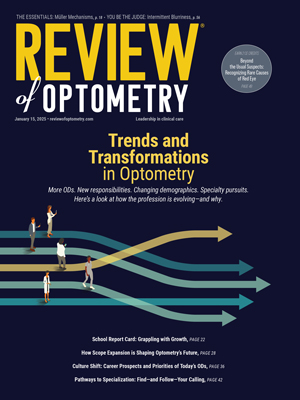|
A global analysis of retinoblastoma that spans 204 countries reveals stark disparities in incidence and mortality. While high-income countries report survival rates over 95%, low-income regions, such as Eastern Sub-Saharan Africa and Andean Latin America, face mortality rates up to 0.17 per 100,000 population. The study also shows that low- and middle-income countries contribute to 85% of global cases, often diagnosing children at an older age, highlighting the critical need for improved early detection and treatment access worldwide. Photo: Julia Canestraro, OD. Click image to enlarge. |
A common intraocular malignancy in infants and young children, retinoblastoma has a global incidence of about one in 15,000 to 20,000 live births. Approximately 95% of cases occur before age five, and it shows no predilection for race or sex; however, the prognosis for those with the disease varies significantly between low- and high-income countries. For example, the survival rate in poorer regions is approximately 50%, while this rate exceeds 95% in high-income nations. Incidence rates also differ between countries. A new study in Ophthalmic Research examined global data and found that Kenya is one of the countries with the heaviest burden, with an incidence of one in 17,030 live births. At the regional level, researchers found a strong correlation between the sociodemographic index (SDI) and age-standardized prevalence rates, underscoring the need for heightened vigilance and targeted strategies to address these disparities across diverse socioeconomic groups.
The data used for this study was obtained from the Global Burden of Disease database, encompassing 204 countries and territories. Information found in the database reports the incidence, mortality and disability-adjusted life years (DALYs) for those experiencing retinoblastoma.
In this study, researchers extracted data about retinoblastoma ranging from the years 1990 to 2021. The global burden of the disease in 2021 was characterized by a prevalence of 57,333.29 cases, representing an age-standardized prevalence rate of 0.86 per 100,000 people, and an annual mortality rate of 0.04 per 100,000.
Although researchers discovered an increase in the total number of prevalent retinoblastoma cases from 42,549.60 in 1990 to 57,333.29 in 2021, they also found a decrease in the number of retinoblastoma-related deaths in that same time period, from 3,179.83 in 1990 to 2,762.04 in 2021.
On a more specific regional level, the highest prevalences of retinoblastoma were reported in Eastern Sub-Saharan Africa (1.82 per 100,000), Andean Latin America (1.65) and Western Europe (1.53). The lowest prevalence rates were found in Caribbean (0.10), Australasia (0.14) and Oceania (0.17). Mortality rates were highest in Eastern Sub-Saharan Africa (0.17), Western Sub-Saharan Africa (0.07) and Andean Latin America (0.04). The lowest mortality rates were observed in Australasia (0.0001), high-income North America (0.002) and Central Europe (0.002). In 2021, the national prevalence of retinoblastoma ranged from 0 to 10.93 cases. Highest prevalences of retinoblastoma were seen in Tokelau, New Zealand (10.93); Kenya (4.62); and Portugal (4.03).
The percentage change in prevalence from 1990 to 2021 varied considerably between countries, with Tokelau (115.6%), Armenia (44.4%) and Cook Islands (10.5%) experiencing the largest increases. Conversely, Cuba (1.0%), Lithuania (0.9%) and Kuwait (0.9%) showed the largest decreases.
According to this study, mortality and the SDI exhibit a negative correlation. “From 1990 to 2021, regions like Eastern Sub−Saharan Africa, Andean Latin America and Central Latin America had mortality rates exceeding those anticipated by their SDI,” the researchers wrote in their paper.” The relationship between disability and SDI is similar to that of mortality, decreasing commensurate with an increase in SDI.
The authors say these shifts may be representative of socioeconomic disparities in health outcomes. “Research indicates significant disparities in global incidence rates across countries and regions with varying economic statuses,” they wrote. “Low- and middle-income countries exhibit markedly higher incidence rates compared to high-income countries,” with about 85% of new global cases originating from poorer countries. “Moreover, economic status significantly influences disease diagnosis timing, progression and treatment modalities,” the researchers pointed out in their article. The age at diagnosis is 30.5 months in low- and middle-income countries, compared to 14.0 months in high-income countries.
“These findings underscore the crucial role of socioeconomic development in the prevention, diagnosis and treatment of retinoblastoma, while also providing essential insights for formulating targeted public health strategies,” they continued.
As for the declining trend in the global mortality burden of the disease, the authors attributed this to the evolution of treatment modalities. “Over the past decades, the therapeutic approach to retinoblastoma has undergone significant transformation, shifting from enucleation as the primary treatment to a multimodal strategy that emphasizes globe preservation and reduction of secondary malignancies,” they said.
The authors say these findings can serve as a valuable tool for healthcare providers and policymakers. “Our exhaustive delineation of the worldwide, regional, and national retinoblastoma burden yields critical insights for anticipating future disease trends,” they wrote. “This detailed comprehension can guide policymakers in the strategic planning of targeted interventions and the allocation of healthcare resources, addressing the evolving challenges posed by retinoblastoma within a progressively intricate healthcare framework.”
| Click here for journal source. |
Feng Y, Feng X, Lv Y. Worldwide burden of retinoblastoma from 1990-2021. Ophthalmic Res. November 13, 2024. [Epub ahead of print.] |


